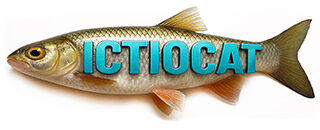Saboga
Alosa fallax

La mida mitjana dels adults és de 40-50 cm i un pes màxim de prop d’1 kg. Té un cos molt comprimit lateralment. Els ulls són grossos i tenen unes membranes adiposes a la part anterior i posterior. El cos és de color platejat amb tonalitats blavoses al dors. Darrere l’opercle tenen algunes taques negres. Es diferencia de la guerxa en el fet que presenta menys de 60 branquioespines als arcs branquials i menys de 60 escates a l’eix longitudinal del cos.
Les diferències genètiques entre la saboga atlàntica i la mediterrània suggereixen que aquesta última es podria considerar com una espècie independent. A Catalunya la saboga actualment és present als rius Ebre i Fluvià, però antigament també es trobava al Llobregat i al Ter, on va desaparèixer a causa dels múltiples impactes ambientals que pateixen.
La saboga és una espècie anàdroma. Els adults viuen al mar i remunten els rius per a la reproducció. S’alimenten de plàncton i d’altres invertebrats, i els adults també de petits peixos.
Distribució

Guerxa
Alosa alosa

La guerxa quan és adulta mesura de 30 a 60 cm i amb pesos fins als 2 kg. Els ulls tenen unes membranes adiposes a la part anterior i posterior. Té una coloració platejada amb tonalitats blavoses al dors. Generalment darrere de l’opercle hi té una taca negra. Es distingeix de la saboga per tenir més de 80 branquioespines als arcs branquials i més de 70 escates a la sèrie longitudinal.
És més abundant a les costes atlàntiques, però és més rara als del vessant mediterrani on moltes poblacions s’han extingit. A Catalunya hi era present al riu Ebre, però la barrera que representa l’assut de Xerta, entre altres impactes com la contaminació i la sobrepesca, va fer que anés disminuint progressivament fins a la seva desaparició durant la dècada de 1960.
És una espècie anàdroma. Els adults viuen al mar i remunten els rius per a reproduir-s’hi a la primavera. S’alimenten d’invertebrats, principalment crustacis planctònics, i ocasionalment de petits peixos.
Distribució

